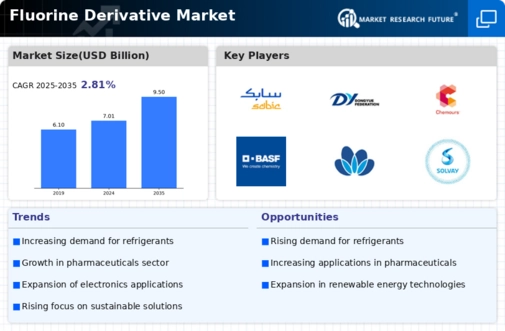Expansion in Agrochemicals
The Fluorine Derivative Market is witnessing significant expansion due to the rising utilization of fluorinated compounds in agrochemicals. These compounds are essential for the development of herbicides, fungicides, and insecticides, which are crucial for enhancing agricultural productivity. The agrochemical sector is projected to grow at a rate of around 5% annually, driven by the increasing need for food security and sustainable farming practices. Fluorine derivatives contribute to the effectiveness of these chemicals, providing enhanced performance and environmental stability. As agricultural practices evolve, the demand for innovative agrochemical solutions is likely to bolster the fluorine derivative market, indicating a robust growth trajectory in the coming years.
Rising Demand in Pharmaceuticals
The Fluorine Derivative Market is experiencing a notable increase in demand from the pharmaceutical sector. Fluorinated compounds are integral in the development of various medications, enhancing their efficacy and stability. The market for fluorinated pharmaceuticals is projected to grow at a compound annual growth rate of approximately 7% over the next five years. This growth is driven by the increasing prevalence of chronic diseases and the need for innovative drug formulations. As pharmaceutical companies continue to invest in research and development, the demand for fluorine derivatives is likely to rise, thereby propelling the overall market forward. Furthermore, the unique properties of fluorine derivatives, such as improved bioavailability and reduced toxicity, make them indispensable in modern medicine.
Growing Applications in Electronics
The Fluorine Derivative Market is increasingly influenced by the growing applications of fluorinated compounds in the electronics sector. Fluorine derivatives are utilized in the production of high-performance materials, such as insulators and semiconductors, which are essential for modern electronic devices. The electronics industry is anticipated to grow at a rate of approximately 6% annually, driven by the demand for advanced technologies and smart devices. As the need for miniaturization and enhanced performance in electronic components rises, the role of fluorine derivatives becomes more critical. This trend suggests a promising outlook for the fluorine derivative market, as manufacturers seek innovative solutions to meet the evolving demands of the electronics sector.
Technological Innovations in Manufacturing
Technological advancements in the manufacturing processes of fluorine derivatives are playing a pivotal role in the Fluorine Derivative Market. Innovations such as improved synthesis methods and enhanced purification techniques are leading to higher yields and reduced production costs. The introduction of green chemistry practices is also gaining traction, promoting environmentally friendly production methods. These advancements not only increase the efficiency of fluorine derivative production but also expand the range of applications for these compounds. As manufacturers adopt cutting-edge technologies, the market is expected to witness a surge in the availability of high-quality fluorine derivatives, catering to diverse industries such as pharmaceuticals, agrochemicals, and electronics.
Increasing Regulatory Support for Fluorine Compounds
The Fluorine Derivative Market is benefiting from increasing regulatory support aimed at promoting the safe use of fluorinated compounds. Governments and regulatory bodies are establishing guidelines that encourage the development and application of fluorine derivatives in various sectors, including pharmaceuticals and agrochemicals. This regulatory framework is designed to ensure safety while fostering innovation. As a result, companies are more inclined to invest in research and development, leading to the introduction of new fluorinated products. The supportive regulatory environment is likely to enhance market growth, as it provides a stable foundation for the continued use and advancement of fluorine derivatives across multiple industries.


















Leave a Comment